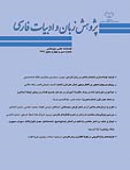شيوه و شگرد بيان «دکتر علي شريعتي» از عاشورا در نثر شاعرانه
محورهای موضوعی : Research in Iranian classical literature
1 - عضو هیات علمی
کلید واژه: حسین وارث آدم شریعتی عاشورا تراژدی هرمنوتیک گادامر,
چکیده مقاله :
این مقاله به تبیین وجوه هرمنوتیک «مقدمه» منثور شاعرانه بر سخنرانی «حسین وارث آدم» در مجموعه آثار شماره 19 علی شریعتی میپردازد. در اینجا، «مقدمه» یک اثر ادبی مستقل و نزدیک به یک متن نمایشی فرض شده که بر اساس پیرنگ و مؤلفههای آن، حامل آثار کارکردی در خواننده و عامل برانگیختن او به کنش اجتماعی است. از سوی دیگر وجه هرمنوتیک آن دلالت بر دغدغههای وجودی نویسنده در باب انسان و سرنوشت و درک نقش تاریخی نویسنده، فارغ از جنبة اثربخشی دارد. عاشورا، محور مرکزی در «مقدمه» است که در مقام یک نمایش تراژیک حامل هر دو جنبة اثربخشی و تأویلی است. نوشتار با تبیین مدعای خود بر اساس یک چارچوب نظری تلفیقی به این نتیجه دست مییابد که «مقدمه» از لحاظ روش و محتوا هم در ذیل کویریات و هم در شمار اسلامیات و اجتماعیات قرار میگیرد و از این منظر واجد کارکردهای یک متن ادبی است.
This article explains functional and hermeneutic aspects of “Introduction” poetic prose of in speech of “Hussein, Inheritor of Adam” in work series No. 19 of Ali Sharia’ti. Here, “Introduction” is assumed as an independent literary work and close to a drama text that based on its theme and components carries functional works into audience and causes social action in its audience. In other hand, its hermeneutic aspect signifies author’s existential problems about human and destiny and helps audience understand historical role of author despite his efficiency. Ashura is the central axis in “Introduction” that carries two aspects of efficiency and hermeneutic in position of a tragic drama. This article explains its claim based on a mixed theoretical framework came to this conclusion that “Introduction” is located below “Kaviriat” based on its method and content and also in categorized as “Islamiat and Ejtema’yiat” and in this view it can be regarded to have features of a literary text.


